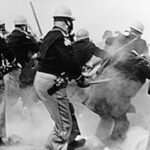This Day in History: 1965-03-07
 African American voting rights activists conduct the first (of three) Selma to Montgomery protest marches in March 1965. This first march is met with violent suppression and the date becomes known worldwide as “Bloody Sunday”.
African American voting rights activists conduct the first (of three) Selma to Montgomery protest marches in March 1965. This first march is met with violent suppression and the date becomes known worldwide as “Bloody Sunday”.
The Selma to Montgomery marches were a series of marches along the 54-mile (87 km) highway from Selma, Alabama, to the state capital of Montgomery, the marches were organized by nonviolent activists to demonstrate the desire of African-American citizens to exercise their constitutional right to vote, in defiance of violent segregationist repression. The marches were part of a broader voting rights movement underway in Selma and throughout the American South. By highlighting racial injustice, they contributed to passage that year of the Voting Rights Act, a landmark federal achievement of the civil rights movement.
The Selma to Montgomery marches were preceded earlier in the year by several local and regional marches protesting the denial of voting rights. Local and state officials sought to fiercely repress the peaceful marches were fiercely suppressed, with approximately 3,000 people arrested by the end of February. On February 26, 1965, activist and deacon Jimmie Lee Jackson died after being shot several days earlier by state trooper James Bonard Fowler, during a peaceful march in nearby Marion, Alabama.
To defuse and refocus the community’s outrage, James Bevel, who was directing SCLC’s Selma voting rights movement, called for a march of dramatic length, from Selma to the state capital of Montgomery. The first march took place on March 7, 1965, organized locally by Bevel, Amelia Boynton, and others. State troopers and county possemen attacked the unarmed marchers with billy clubs and tear gas after they passed over the county line, and the event became known as Bloody Sunday. Law enforcement beat Boynton unconscious, and the media publicized worldwide a picture of her lying wounded on the Edmund Pettus Bridge. Learn more.
